Unresolved
10/24/2024 - Adjusting to new unknowns
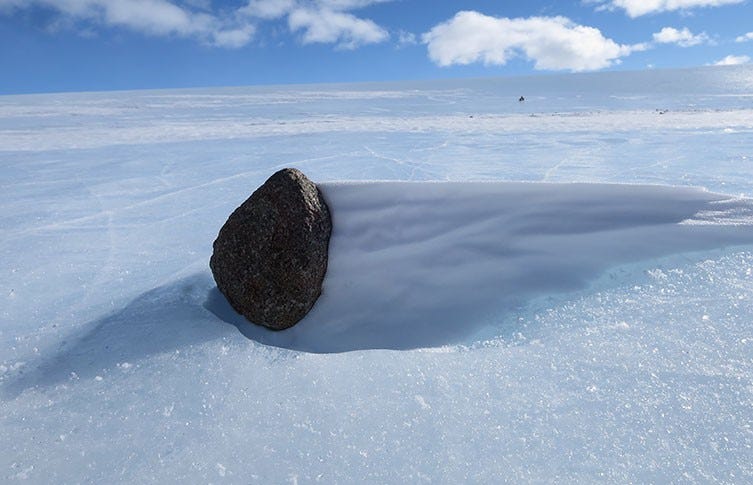
Hello everyone:
As always, please remember to scroll past the end of the essay to read some curated Anthropocene news.
Now on to this week’s writing:
In one of the luckier moments in a lucky life, I reached down from the seat of my snowmobile while working on an Antarctic glacier and picked up a softball-sized meteorite. The exterior was marked by a dark brown fusion crust, the melted surface of an iron-rich stone that had sizzled through Earth’s atmosphere before plunging, in some long-ago epoch, into the cold bath of the ice cap.
My hands, the first to touch this object of deep time, had no idea how to tell my mind what they held. Or perhaps the reverse is true: my hands confidently said “stone,” while my mind foundered on “asteroid.” How long did it take to travel through our atmosphere to the depths of glacial ice? Seconds, I suppose. How long was its journey back up to the glacial surface? How long between fiery arrival and casual acquisition by a hairless ape in insulated Carhartts? Centuries, millennia, eons? Hard to say.
But here’s the real question: How long was this fragment moving through space before it was snagged by our planet’s gravitational net? About four and a half billion years, the same age as the Earth.
Four and a half billion years: An amount of time we can name but cannot grasp. I felt like I should play god and gardener with the thing, gently setting it back into space with a dressing of organic chemicals - the two-cycle oil smeared on my work gloves was probably insufficient - and wish it well in sprouting life during some distant galactic era.
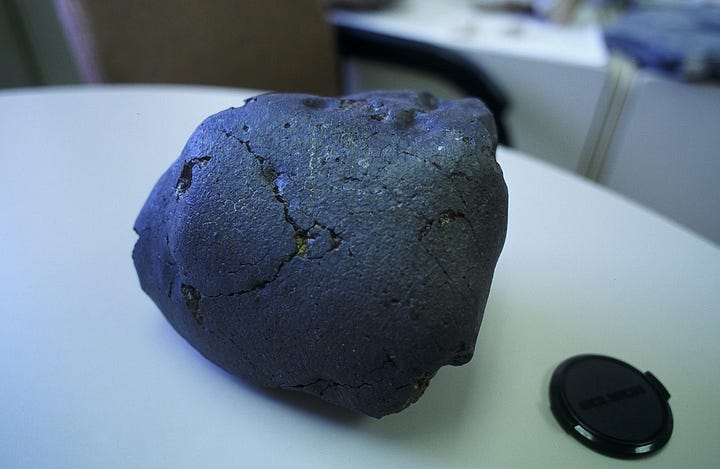

But its destiny, in human terms, is to rest here on Earth, specifically (I think) in some drawer at the Smithsonian. To us, its life seems finally resolved. This piece of asteroid had missed out on the planet-making glory days of early solar system history, existing instead as a lone crumb on the astrophysical tablecloth. Until now, here, finally at home with us.
Right? Or maybe not. Certainly it has melded with the massive body we call a planet. But planets and stars are dust in the astrophysical wind. On that scale, we don’t know where we live or what any of it means. We grasp neither the bulk of what makes up the universe, nor the container it’s in, nor where any of it is going. In our confusion, we believe that numbers define time rather than simply telling stories about it.
The meteorite, like us, is still unresolved.
Which is fine. Beautiful, even.
All identities are unresolved, it seems to me. Everything is in motion. The recipe for matter is energy thickened with time, all of it as likely to be eaten by entropy as a cookie warm out of the oven. What we think of as a fixed world made of solid objects is neither fixed nor solid, neither fixed nor broken.
Mountains rise and fall. Continents bob and sink back into magma, oceans stretch wide and then close up. The delicate atmosphere clings like thin film to the Earth but roils in constant motion, spinning up cyclones and tornadoes like small eddies in a stream. The constant churn of soil and seed into plant and animal, and back again, regulates much of the flow of water through earth and sky.
The lines we draw between species grow thin as we find that life is far more subtle than our ideas. Microbes hand genes to each other like currency. A broad glance at the animal kingdom belies our cultural insistence on defined gender and sexuality. Our entire notion of “individual” was never real, as we find organisms are really communal containers for life linked inextricably to an endless chain of other living communities. As
told me recently (citing a philosopher/farmer in VT), our bodies are “tenement housing for bacteria” rather than a solitary ape’s proud domain.I don’t know about you, but to me, after a lifetime of experience, everything from galaxies to consciousness seems to emerge and disappear on equal terms.
If this high-flying talk feels a bit tenuous, then we can agree at least on the unresolved nature of human affairs. The turbulence of politics, community, and personal relationships buffet us daily. We all want, as Bob Dylan sang, a little shelter from the storm:
Not a word was spoke between us, there was little risk involved Everything up to that point had been left unresolved Try imagining a place where it’s always safe and warm “Come in,” she said, “I’ll give you shelter from the storm.”
We might be excused for worrying about the fact that everything is as unresolved as the surface of the sea. If you’re lucky enough to live near an ocean (or any water complicated by the wind), watch the constant flux in its skin for the best map of reality I know. Patterns arise out of near and distant forces, combining and overlapping into what we’re sure is chaos.
Bobbing amid my oceanic map here in coastal Maine, though, are reminders that while the complexity is greater than our own, it’s still kin and kind to us. Rockweed sways in high water, rests comfortably at low. Common eiders are calm or even asleep among the waves, not looking for resolution. Gulls fly by, above it all. Beyond them are islands reminding us that solidity and safety exist within the chaos, if not on the scale we’d prefer. Then we turn back to the land to realize that continents are islands too, as is this planet.
This, then, is the cosmic setting for the intensification of Earth-borne atmospheric, geochemical, and biological turmoil in the Anthropocene. Against the normal background of flux and entropy that stretches from the cells in your fingertips past the asteroid belt between Mars and Jupiter (that likely spawned my meteorite) to the edges of the “known” universe, we’ve tipped the planetary balance toward a fate that challenges algae, eider, and gull to keep up with a speed of change not seen since a six-mile-wide (10 km) asteroid wiped out about 75% of Earth’s wildlife 66 million years ago.
We’re not that destructive yet, nor are we condemned to be. Nor are we an asteroid, though some of us are collectively acting like one that’s trying to leave the planet, disrupting the fabric of life on our way out, as if the Earth were little more than a scorched launch pad for our antibiotic dreams.
It’s heartbreaking, really, to live a life that senses the astonishing beauty and complexity of the physical universe and biological world, and to know that at our best we’re a wondrous part of all of it, all while watching the tragedy unfold. Deep empathy for other life is always a hard road, but in the Anthropocene it’s brutal. And now we’ve rapidly entered the stage of the tragedy where the effects of our erasure of life and especially our heating of the atmosphere are coming at us hot and fast.
Empathy for our fellow humans caught in flood and drought, heat and hurricane, will be hard enough.
Here’s
, who writes , writing quick notes from Hurricane Helene’s destruction in the mountains of North Carolina, working like hell with her neighbors to stabilize roads, homes, lives, community, and relationship with a weirdly turbulent world:We don’t yet have the leadership here that understands 1) what happened, 2) the huge gap between those with generators and solar and those without, 3) how to change from a consumptive-driven American to a neighborhood that listens to what the mountain is teaching us. And I can’t yet figure out how to say that because I live here and even knowing what I know, don’t have a way to articulate the way forward.
I had lost 15 pounds through physical labor, adrenaline, and simply not having a way to store perishable food… In the grocery store, my face, a reflection on the freezer door, looked haunted. I was chewed up inside, hungry for a hot meal.
Last night, I moved my “go bag” away from my pillow for the first time since my phone blared Helene’s emergency warning [18 days earlier]. Today, I still keep the 24/7 county emergency phone number in my pocket. It’s a little square of paper that suggests someone will help.
Why do I tell you this? If Helene could hit Asheville, then the lines ~ we’ve crossed since 1856 when Eunice Newton Foote, scientist and women’s rights activist, proved in a simple backyard experiment that carbon dioxide heats up and holds heat longer than regular air ~ are catching up with us. Even the sanctuary spaces billed as climate havens are vulnerable and fragile.
Hug your people. Hug them hard.
And here’s
of in a piece composed of 14 short scenes after Helene upended life in Georgia:The baby lay on the bed between Raven and me. She was two months old and this was her second hurricane. I asked Raven again about the storm’s path. He had checked the weather just before bed. The last he’d seen, he told me, speaking through the howling dark, the hurricane would come ashore around Perry and travel up I-75 toward Atlanta, two hours west. I thought of my friends in other parts. How fast is the storm moving? I asked Raven. About 30 miles an hour, he said. Then it will be past us soon, I said.
I had a strange feeling, however. People are dying right now.
Maybe not, he said. But you know how quickly a path can change.
And here’s my friend Mark, in an email, talking about the scale of what’s been lost in Florida, hurricane after hurricane, just as Milton was churning as a Category 5 across the Gulf:
So Helene covered Little Gasparilla Island with 5-7 feet of water. We have a few friends that stayed, their video and accounts were pretty grim to watch in real time. In the area we hang around in, ten houses that we know of were lost, three of them burned down (lithium batteries don’t do well in salt water apparently), five were knocked over and ripped apart, and two just vanished... gone... not a trace.
I can think of another dozen or so that would have been totaled by that depth of water.
I’ve no idea as to what happened elsewhere on the island. Along with the houses that disappeared, so did the sandbar that ran the length of the island on the gulf side, as well as all the dunes.
There is nothing left to slow any surge that will arrive this week… as of now predicted to be in the 9-12 ft range.
We’ve got friends who live out there, whose houses were annihilated by Ian, put their lives back together, and now are wondering about losing everything again. If you have built a life, if you are a member of a community, if you have a job, it’s not that easy to pull up stakes and leave.
Though I suppose if you have nothing but the clothes on your back you don’t have to worry about renting UHauls.
Deb and I have had a strange view of all this. Since we started exploring SW Florida 10 years ago or so, we have stayed in places that have been, since 2017 with Irma, obliterated: Everglades City, Goodland, Sanibel, Cedar Key, Little Gasparilla Island, Navarro. And everywhere in between, everywhere we’ve been along that coast, from the Everglades to the panhandle.
Of the nine campgrounds we haunted, five have been under 5-15 ft of water since 2022. I assume that three of the others suffered major damage too. Only one of those five is located near the coast.
All my pretty writing about the unresolved nature of our cosmic existence, of the universe itself, is useless here. The sunlit sparkle off the astonishing skin of the sea is little comfort for the flood-forced homeless, for the bankrupt-because-insurance-won’t-pay, and for the communities that will face the intensified storms again next year.
Finding peace within the vagaries of the ordinary turbulent world is one thing - fires and floods and storms are part of the fabric - but it’s infuriating and sad to navigate our relationship to the chaos when you know the worst of it emanates out of a century of half-witted greed and blind self-interest. And our children and grandchildren, even if we make this right, will still be coping with much deeper impacts before the arc of empathy truly embraces the beautiful world.
So what does it mean to feel unresolved at a crux in both human and Earth history? To be at loose ends amid the unraveling of social and ecological norms? It means, I think, that empathy is the only philosophy that matters. The Anthropocene is a human era, after all, and we have to fix what we broke. And we have to do it while caring for those who get broken by it, both human and more-than-human.
Hug your neighbors. Hug them hard.
The good news is that communities of haves and have-nots are already working together - fitfully and insufficiently, I know - around the world to patch things up. All the good work being done by tens of millions of people, whether giving bequests to conservation groups or planting mangroves in Bangladesh, whether funding climate-conscious candidates or chaining themselves to bank doors, are efforts to soothe the sea.
I took a walk recently on a favorite trail just a few miles from home, a trail that winds a mile or so to the ocean. I was thinking about this piece and about unresolved family matters, and so scarcely noticed the forest, the perfect autumn weather, any of it. It was that all-too-common experience of the fog of perceived individuality - I think, therefore I am - that fills our days and haunts the world. Finally, though, I slowly became aware of the roar, no, hum of the sea. Essay, worries, and other self-interest set aside, I broke out into the open and found my eiders and islands and, eventually, a more convivial path home. When back at the car I realized that the ocean’s tone and surge had been there all along. As are galaxies and asteroids, fingertips and hugs, ends and beginnings.
I’ve led a lucky life. But you don’t need to stumble upon a softball-sized shooting star to sense the unresolved patterns of change in the universe and to feel the requisite awe. A bumblebee or minnow will do. A grain of sand, even. But the pattern we must discern among all others right now is empathy, and where we cannot see it we must become it.
Thanks for sticking with me.
In other Anthropocene news:
From Vox, a good-news story about the Coeur d’Alene Tribe in Idaho working on a generational scale to revive the land and the food culture they built upon it for millennia before colonization.
In related news, the new podcast Fuel to Fork. I haven’t listened to it but it comes with a recommendation by Bill McKibben. Fuel to Fork is a multi-episode account of the growing role fossil fuels have played in modern agriculture and our food system.
From the Times, a useful if weirdly calm news-you-can-use list of tips for reducing your exposure to the toxic and ubiquitous class of PFAS chemicals that are currently haunting all aspects of civilization. The tips include precautions around food, water, the home, and things that touch our skin. Everything, in other words.
Also from the Times, a final word from a reporter leaving their Climate Forward newsletter on her most important message to you and me: the climate and biodiversity crises are woven together and equally important. It’s a message that all major media should be making clear, every day.
And, why not, one more from the Times… this one about the latest Living Planet Index report and its always shocking account of the decline in wildlife populations. The Times piece is a good explainer about a report that’s dire but still often misunderstood. I wrote about the previous report two years ago.
Some related information from Our World in Data: “Wild mammals make up only a few percent of the world’s mammals.” This is something you’ve heard me cite quite often over the last few years, but it’s something I’ll keep citing, because our primary relationship to life on Earth is often our affection for charismatic wild animals, usually mammals. All the polar bears, elephants, wild horses, hippos, tigers, meerkats, etc., every wild mammal you can name, if they were all added together, form just 4% of the planet’s mammalian biomass. The other 96% are us and our livestock. If you can grasp that, the scale of the Anthropocene suddenly becomes clear.
From Bryan Pfeiffer and
, a wonderful story about falling conifer needles, an endangered thrush, and a tiny mushroom. As always, Bryan guides us with style, grace, and humor into a deeper relationship with the natural world.From Inside Clean News, a new nonprofit called Greenlight is mustering forces and considerable funds to help local groups who want to support green energy projects in their community. When these projects come up for approval before local boards, opponents armed with misinformation from fossil fuel interests can dominate the meetings. Greenlight “aims to alert local groups and people of the issues in their communities, and foster greater participation by people who support a shift to cleaner energy.”
From Euro News, a fascinating development for solar panel deployment in northern climates. Small, two-sided, vertically-oriented panels produce significantly more power than traditional panels, in part because they remain cooler (hotter panels produce less power) and because fallen snow reflects light back up onto the solar cells. This improvement can translate to southern climes as well, esp. if placed on white rooftops. Expect to see much more vertical panel deployment in the future.
From Stop Project 2025, a collection of cartoons taking on the planned destruction of American governance in the quest for a fascist Christian nationalism. For my purposes here, there are cartoons exploring plans to repeal any and all climate measures and dismantle the EPA.



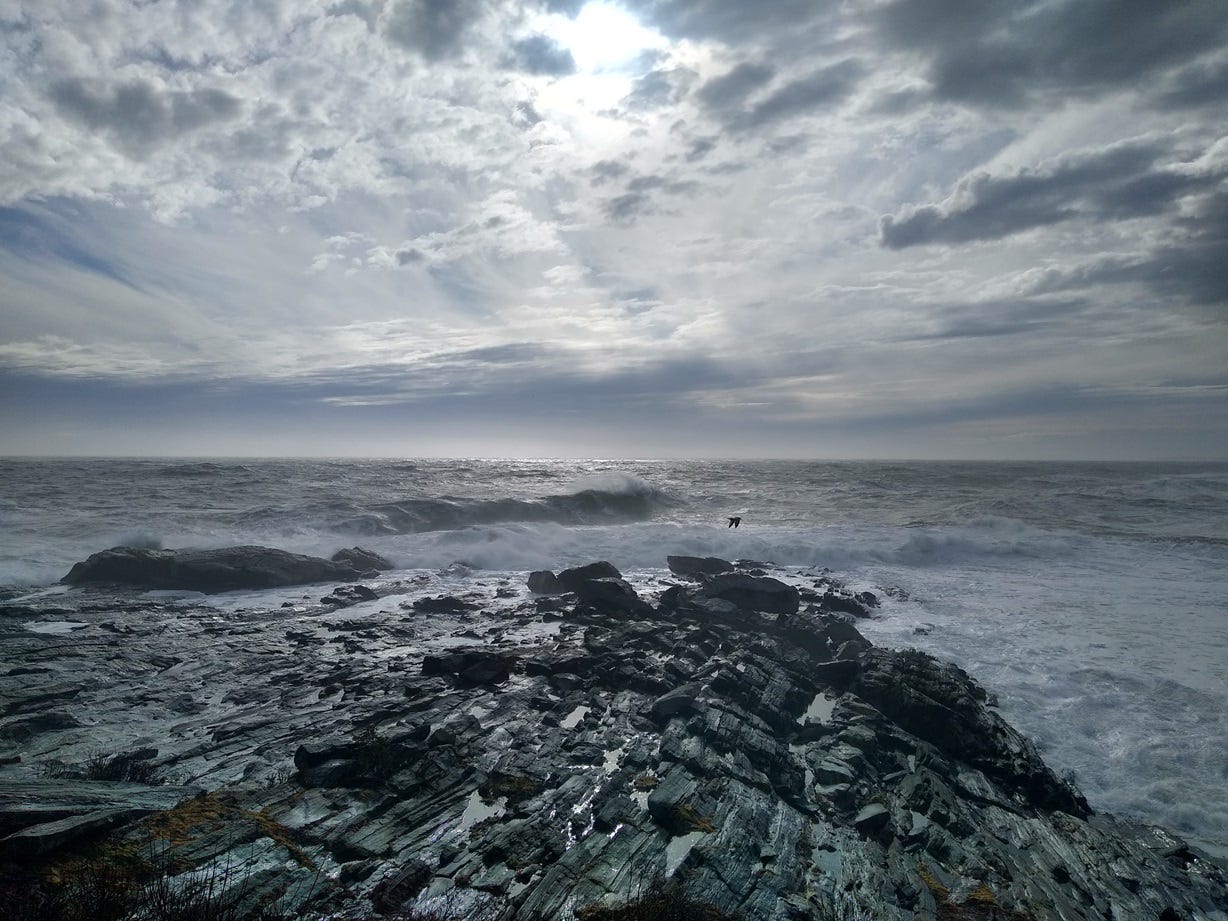
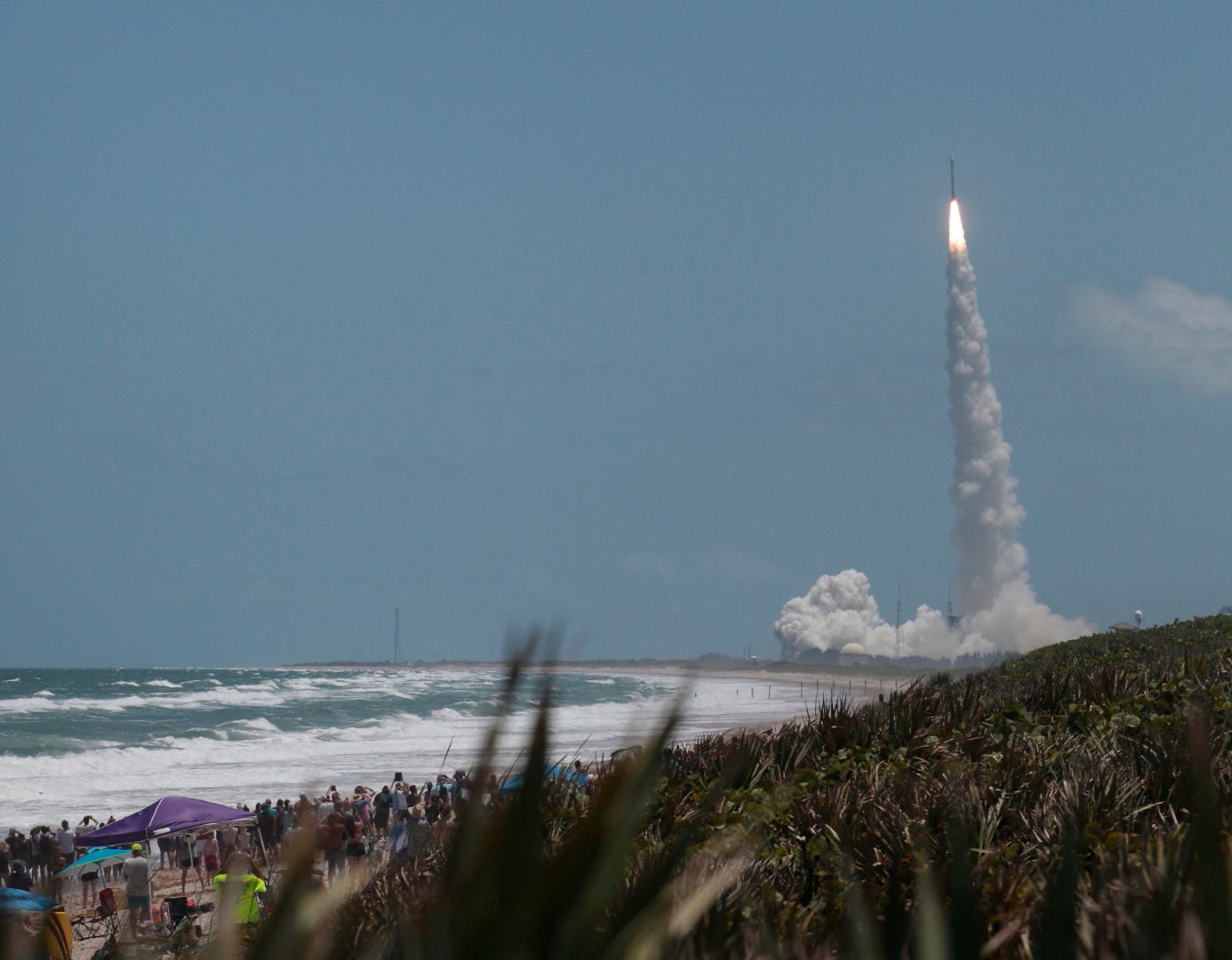
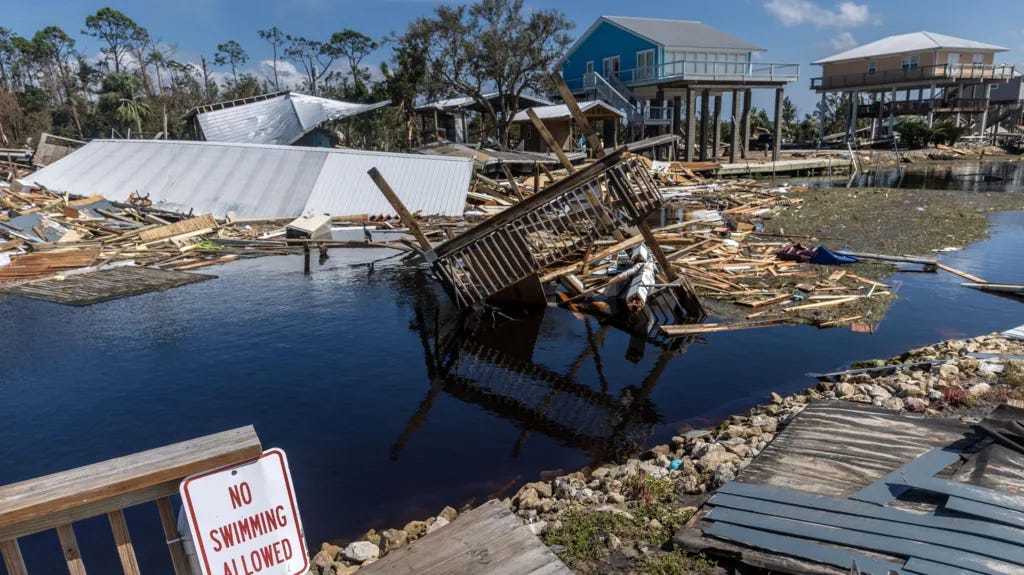

Reading this essay was like sitting rapt listening to a great swelling piece of symphonic music. Starting small with just a flute solo, then more instruments coming in, building to a prolonged crescendo and then dying away to end with the solitary flute again. A great piece of music one realizes, a great piece of writing.
All things pass away, both the good and the bad. The music ends, the audience departs. Everything is in motion. Even the asteroid in the box might someday return home to space. But compassion and love never change. They are woven into the fabric of space itself. This is a certainty.
Wonderful writing, catching the cosmic and the immediate. Thank you, and thanks to Katharine Beckett Winship for re-stacking